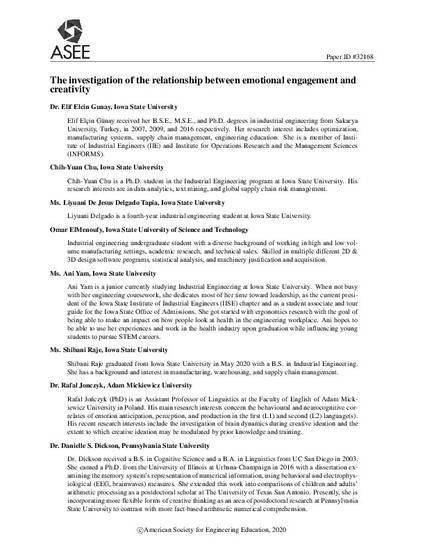
Background - One of the most critical challenges in engineering education is improving students’ divergent thinking skills. Usually, we observe students’ fixating on only one single solution for engineering problems. However, their ability to think outside the box and provide alternative solutions should be developed. Research shows that engagement may foster the development of thoughts and boost creativity.
Purpose/Hypothesis – Our aim was to investigate students’ engagement with tasks that inspire different facets of creativity (verbal, numeric, and visual). Considering the role of demographics in student engagement, we explored the relationship between their engagement level and demographic traits such as gender, major, age, grades (GPA), and the languages they know besides their native tongue.
Design/Method - We utilized electrodermal activity (EDA) sensors, a well-documented proxy of emotional engagement, to measure students’ engagement level while performing tasks that inspire different facets of creativity (verbal, numeric, and visual). Due to the non-normal distribution of the data, non-parametric statistical tests were conducted considering engagement as a dependent variable and demographic traits as independent variables.
Results - Statistically significant differences in students’ engagement when exposed to creativity inspired tasks were observed. However, no association between demographics and engagement levels were detected.
Conclusions - The results of the study may support educators in designing the instructional materials considering creativity-inspired activities so that students’ engagement level can be increased. Further, results from this study can inform experimental designs, specifically participant selection, in engagement focused studies.
Available at: http://works.bepress.com/gul-kremer/193/

This proceeding is published as Gunay, E.E., Chu, C.Y., De Jesus Delgado Tapia, L., El Menoufy, O., Yam, A., Raje, S., Jonczyk, R., Dickson, D.S., van Hell, J., Siddique, Z. and Okudan-Kremer, G.E. The Investigation of the Relationship Between Emotional Engagement and Creativity. Paper ID #32168. 2020 ASEE North Midwest Section Annual Conference. Posted with permission.